Food. The basic need for survival. An integral part of life. It has existed since the dawn of time, and without it, there would be no you and me.
Early humans did not have it as easy as we have it today for food to be produced. They had to go over a long thousand years to properly comprehend the necessity of food, how to consume it, how to produce, and how to sustain it.
The importance of storing food and regrowing it was understood at a later point in time in human evolution. With the growing population and the rapid diminishing of ready food, the realization hit them, and that’s how the thought of ‘agriculture’ came about.
In the beginning, it was not very refined and not as developed as today. Constant tweakings and nippings throughout lifetimes, generations after generations with the added experience, lead to more complex methods of doing agriculture.
The History of Agriculture
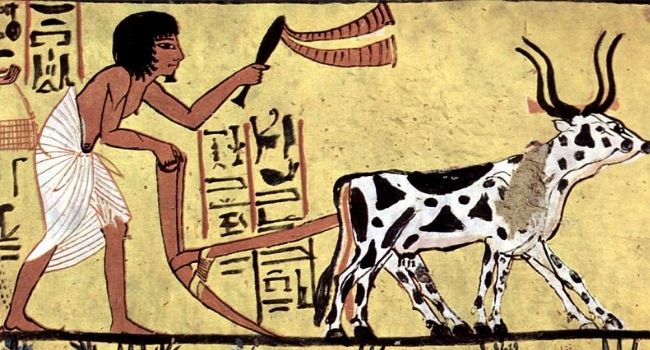
The concept of agriculture has multiple origins from different parts of the world and different continents all together too.
Since there was no form of immediate communication, they could not share their innovations, resulting in varying evidence dates of the initiation of agriculture. The majority of the reports suggest the earliest be from ‘Southwest Asia.’
‘Farming’ was the name given to agriculture in its early days. It started in the ‘Predynastic Period,’ which comes at the end of the ‘Paleolithic Era,’ after 10,000 B.C.
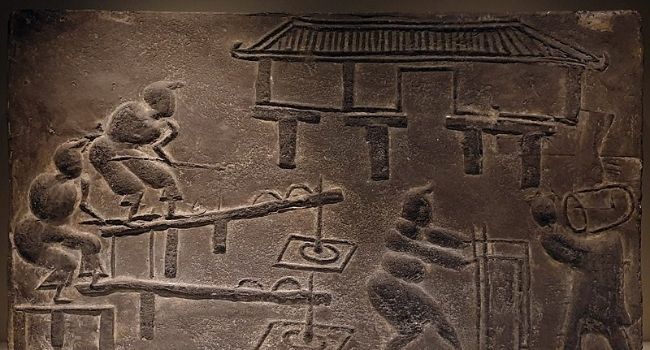
The early menu consisted of ‘semi-solid rachis’ (rachis meaning, the softer or thinner part of a plant, usually between the leaves) and ‘large-sized seeds.’
When 9,500 B.C. came around, there were now 8 significant forms of food divisions. They were – majorly emmer and einkorn wheat, followed by hulled barley, peas, lentils, bitter vetch, chickpeas, and flax. ‘Wheat’ and ‘Barley’ were consumed the most, with ‘Flax’ and ‘Papyrus’ in lower amounts.
There were many forms of ancient agriculture. Some of them being – ‘Sumerian Agriculture’ of Sumer (present day-Iraq), ‘Aztec and Maya Agriculture’ in Mesoamerica (present day-North America), ‘Roman Agriculture’ (present day-Rome), ‘Chinese Agriculture’ (present day-China), and ‘Indian Agriculture.’
When did Agriculture Begin?
If we look at our history, there have always been patterns in which things came about. We just have to take a deeper look into it to decipher the code. The same is in the case of agriculture.
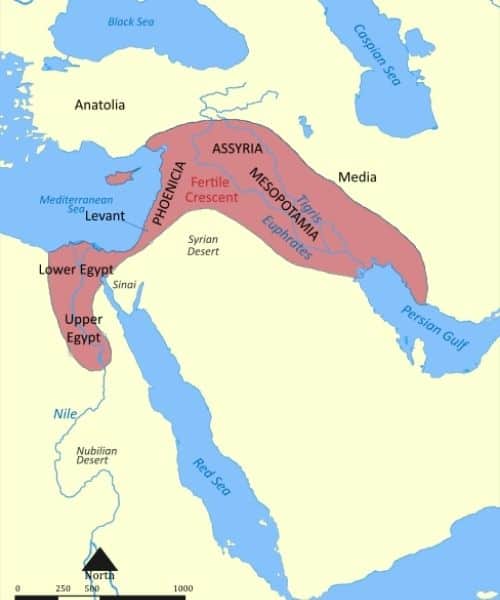
A very vague idea is that some plants and animals started self-domestication at fixed places. In search of food and water, humans began settling down near those areas and thus started civilizing them.
The first noticeable commonly agreed upon proof is ‘The Fertile Crescent,’ also known as ‘Cradle of Civilization,’ claimed to birth the idea of agriculture. Mesopotamia and Levant regions were also part of this Crescent.
The term ‘The Fertile Crescent’ was coined by an archaeologist of the University of Chicago named James Henry Breasted.
He called it so because of its shape on the map. The Crescent is formed by countries of present-day Egypt, Jordan, Lebanon, Palestine, Israel, Syria, Turkey, Iran, Iraq, and Cyprus.
The lesser-known reason is that the humans thought of agriculture as a more efficient way of getting food rather than moving about ‘hunting and gathering.’
What Event Enabled the Evolution of Agriculture
No one event, in particular, enabled the evolution of agriculture. The Earth has since the beginning a developing planet. It has undergone numerous changes regarding time, space, land; earthquakes, volcanoes, landslides, temperatures; both extreme hot and cold, water; rainfall, blizzard, hailstorms, tsunamis, cyclones, etc., beyond the comprehension of humans.
These certainly impacted, giving a push to the start of a cascade of changes necessary for its survival. And the aftermath and side-effects may have indirectly influenced certain sudden changes.
The transition of humans from being ‘Hunter-gatherers’ to ‘Agricultures’ is contributed by several factors, but the pieces of evidence are inconclusive or have divergent origins. Two of the major factors are –
- Climate change – Earth was entering into a warmer trend at the end of the last Ice Age.
- Intelligence development in human brains
The shift is also said to have been ‘the Neolithic Period’ in the chronology of agricultural development.
Stages of Evolution of Agriculture
When an idea is conceived in one’s mind, the next course of action is to gather the required tools to perform the concept practically.
And so, the idea of cultivation needed a set of tools for its actual projection. The tools were for them to begin digging the ground, placing the seeds, and then covering them with soil. With development through the many eras, agriculture became just more than the three acts.
Another crucial element to be considered before the initiation of cultivation was ‘irrigation.’ The supply of water is a must for growing crops and thus needed to be channelised in the fields at suitable times and in the right amount. Therefore, simple contraptions were then built to water the pastures at regular intervals.
Now that the problem of water was solved, then comes farming equipment to be utilized.
Let us look at some of the ancient tools, developing to the tools used nowadays.
Ancient Tools
These are very primitive and under-developed compared to modern-day tools, but they were the most advanced in the olden times. Strong and longer durability than today’s tools.
- Stone Age Axe
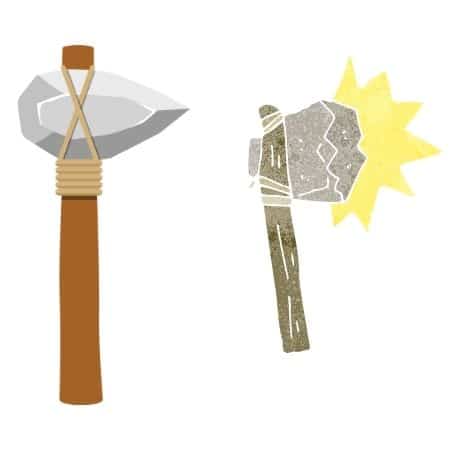
It consisted of a sharp stone of different sizes and shapes. Initially used by hand, but due to bruising and scraping, a thick wooden stem as a ‘handle’ was tied later. This gave a better grip and safety. It was used to cut wood.
Other materials like iron, copper, or bronze were used instead of wood in the later years or ages.
2. Plough
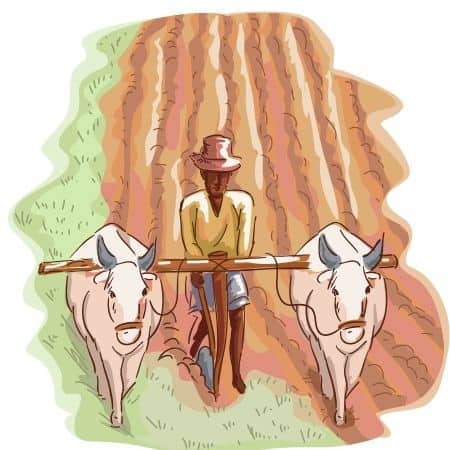
It was made up of a long wooden stick with a sharper one attached horizontally perpendicular to the first one. It was used to dig the ground and required a tremendous amount of force by the hands.
In the later years or ages, it was tied to animals, and then the animals were made to move forward while dragging the plough along with them, in the process digging the ground.
3. Digging Stick
A long stick, almost the height of a man or maybe longer. It was used to loosen the soil and till it. Sometimes a handle was attached to it for better grip and handling.
4. Hoe
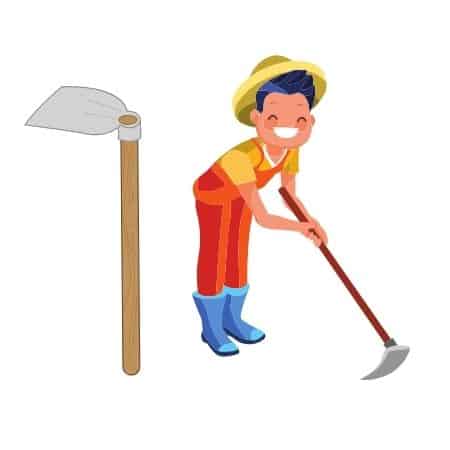
Similar to Plough but instead of a sharp end, this has a rectangular flattened head. Inferior to Plough in strength and is used to move less soil than digging the ground.
5. Sickle/Scythe
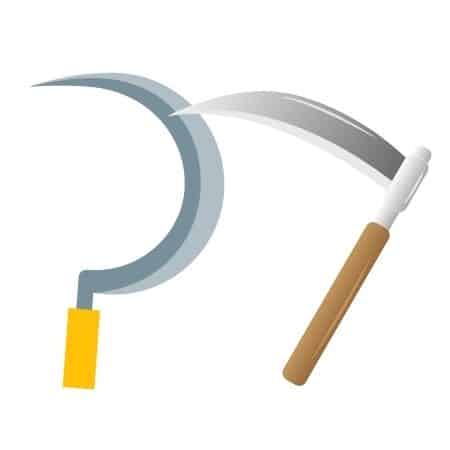
The Sickle has a short thick handle, with a crescent-shaped stone or metal-based edge, which cuts the crop in one sharp swipe. Scythe is also pretty much the same, but the handle is thinner and longer.
This was used to harvest the end product, i.e., the fully grown plants, and crops.
Modern Tools
Observe how almost all the tools have the word ‘automatic’ before them. Yes. In today’s world, more than half the things work automatically, without any manual assistance. This has saved time due to their speed and precision and money, because the owners will not have to pay any wages to manual laborers.
- Automatic Harvester
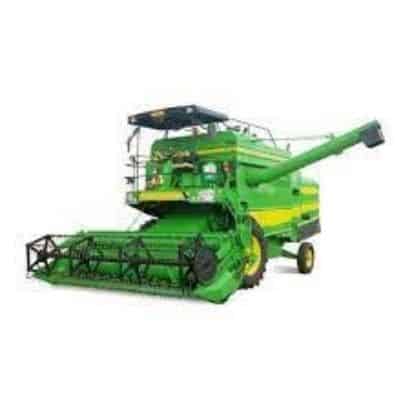
A regular tractor is fixed with the harvester in the front. The tractor is then run over the crop-ready fields, and the harvester harvests them with precision and efficiency. The size of the harvester differs depending upon the area to be harvested.
2. Automatic Row Weeder
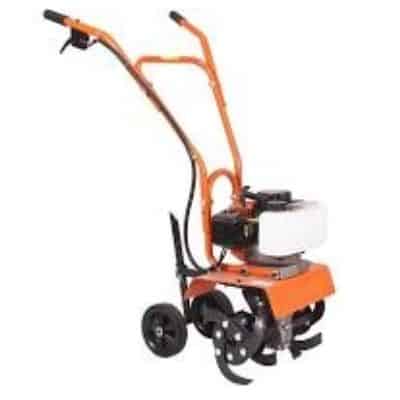
Weeds are unwanted plants that grow with the main crop due to the availability of favorable conditions. But these also utilize the nutrients and fertilizers necessary for the growth of the crop. This causes the crops to suffer from malnutrition and stunted growth, the same of which the human consuming it will suffer too.
Therefore, it is mandatory to remove them at regular intervals to avoid poor growth and development of the main crop. The Row Weeder does that same job for us. It removes all the weeds, even the tiniest ones, perfectly and maintains proper rows without mixing them while rooting them out.
3. Automatic Separator
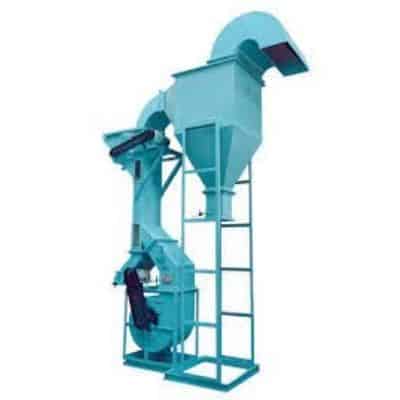
This is mainly used for grains like rice, wheat, barley, jowar, etc., to remove their husks. The separation of husk and the actual edible grain is essential for consumption since husk is harmful.
In the olden days, manual threshing was done to remove these husks, but some still stuck to the grain and caused distaste and upset stomach. This separator is the best solution to the problem. It saves the energy of threshing the dried crops on the floor with immense force.
4. Sprayer Pump
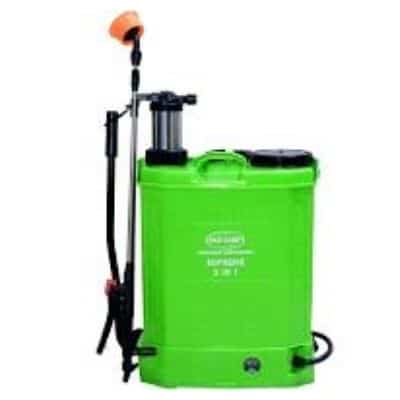
It is very handy and can be used for multi-purposes. Unlike the pre-tech times, where each farmer/cultivator had to sprinkle the crops with pesticides, insecticides, or fertilizers using hands and three different batches, this sprayer saves that time.
It has to be simply filled with whatever chemical you want to spray at one time and use it. It can spray all three chemicals in lesser time than one chemical by hand. A good bargain indeed.
5. Seed Drill
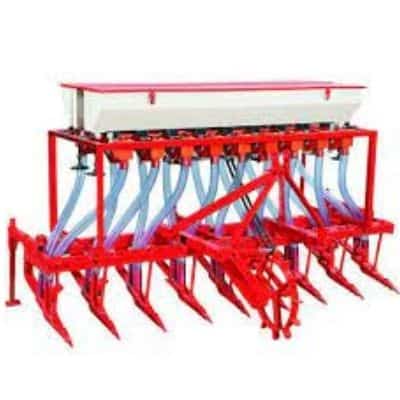
This is fixed in front of a regular tractor. The container above the contraption is filled with seeds to be sown. This container is then connected through pipes to the drills at the bottom.
As the tractor moves, the drills drill the ground, creating holes for the seeds flowing from the pipes to fall in each hole and get planted. This saves the time of the farmer/cultivator in the multifold. The time duration for hand-sowing is vastly cut down by using a Seed Drill.
The differences between the ancient tools and the modern tools are pronounced and distinct. It displays the vast spectrum of technology from then to now.
Timeline
A timeline shows the step-by-step development of agricultural advancements in tools, production time and cost, profit, loss, and much more.
The following flowchart gives an overview of agricultural development over the years.
9000 – 7000 BC
Agriculture was discovered and developed.
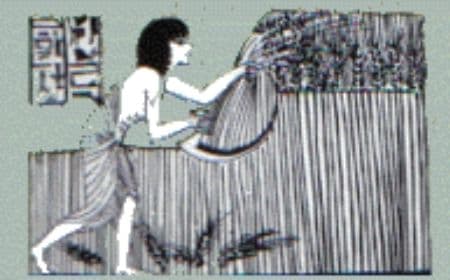
↓
7000 – 3000 BC
The variety in food being produced increased along with the introduction of irrigation. Animal rearing had also begun.
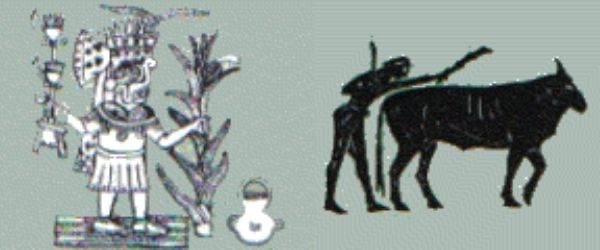
↓
3000 BC – 800 AD
Crop rotation had begun, i.e., more than one batch of each crop was produced.
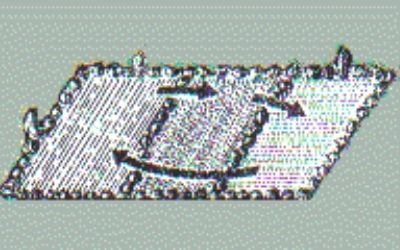
↓
800 – 1500 AD
Inter-state and Inter-country trading of crops was initiated. The crops were now divided into domestic crops like vegetables, commercial crops like coffee, and beans.
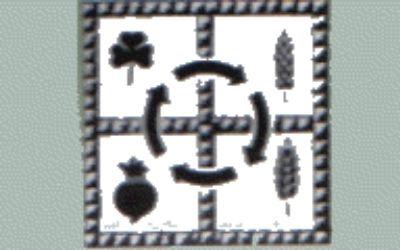
↓
1500 AD – 1700 AD
Tools for propagating agriculture had gained attention other than just producing crops, so advancements in tools like ‘fiber separator,’ ‘reaper’ along with fertilizers like ‘superphosphate’ began.

↓
1700 AD – 1900 AD
Experiments by the Scientist Mendel in crops based on Genetics improved their quality. Long-distance shipping was now possible due to the development of inland and ship routes.
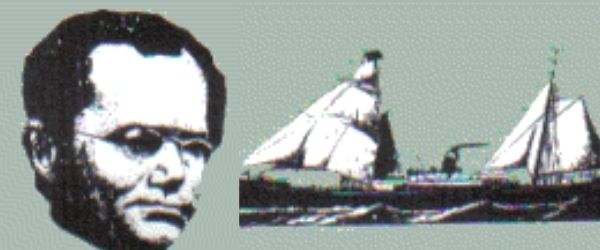
↓
1900 AD – 1970 AD
Huge advancements in machinery and productivity. A large number of people took up jobs in the agricultural sector. Advanced scientific methods and techniques were introduced for the analysis of crops.
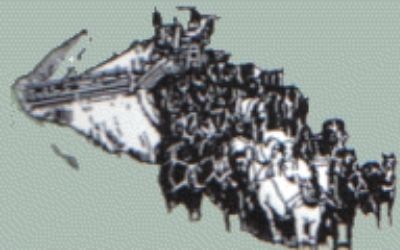
↓
1970 AD – Present
Technology has taken over every aspect of farming and agriculture. Everything is based on computerized calculations, from the percentage of good crop production to automated fertilizer systems.
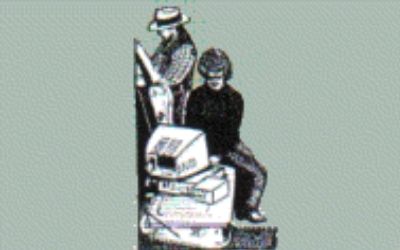
Evolution of Agriculture in Insects
Since the dawn of agriculture, it underwent innumerable changes. Along with humans, creatures of all kinds were also affected, either directly or indirectly.
An ecosystem encompasses all, living and nonliving. So, any change in one ecosystem element induces a difference in the elements interconnected with it.
The same happened in the case of the evolution of agriculture in insects. Notably, 3 types of insects also evolved with agriculture – Ants, Termites, and Ambrosia Beetles.
Though these 3 categories of insects are quite different from each other, but fundamentally similar in some characteristics, hinting at convergent evolution (different to one).
Insect farmers are a category of farmers who propagate insects for their by-products. These may include silk or honey from silkworms and honey bees. The problem arises when both the insects and crops are needed to cultivate together.
So, for this, the farmers have taken specific measures to avoid any joint damage. They are –
- Isolating their crop fields from insect breeding grounds.
- Keen monitoring and control of crops to detect early infestations and treat them at the earliest.
- Growing genetically different crops, which does not allow a certain group of insects to infect them.
- Introducing particular microbes in the crops, which cause ‘disease suppression.’
Influence of insects on agriculture has been witnessed for thousands of years. This co-relationship should not be underestimated, and its benefits must be yielded as much as possible.
Conclusion
The Evolution of Agriculture is unlike anything the world has seen or has ever witnessed. The phenomenon was on such a large scale that another one of its kind seems next to impossible to occur.
This evolution has also shown the extent to which humankind can go to get what they want, whether it be for convenience or lack of better quality or aiming for better livelihood.
All this contributes to the only factor of bettering ourselves one day at a time to the next advancement waiting for us to be achieved.
Reference for Images:
